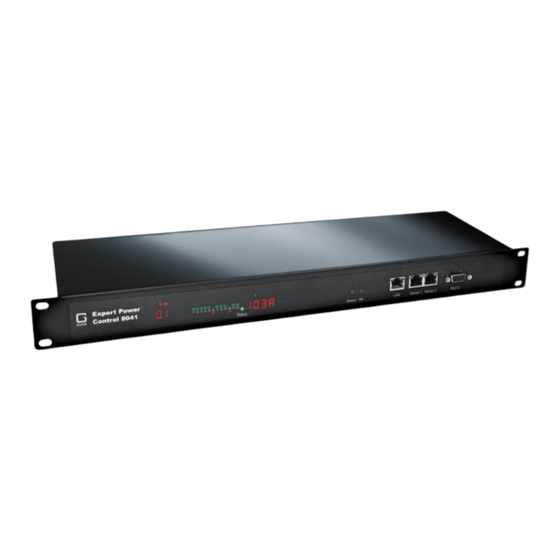
Summarization of Contents
Device Description
1.1 Security Advice
Essential safety precautions for device installation and usage by qualified personnel.
1.2 Content of Delivery
Lists the items included in the Expert Power Control 8041/8045 package.
1.3 Product Description
Overview of the Expert Power Control 8041/8045 features, including load outputs and connectivity.
1.4 Installation Guide
Details the two variants of the Expert Power Control 8041/8045 and their displays.
1.5 Residual Current Type A Measurement
Explains the measurement of sinusoidal and pulsating direct fault currents.
1.6 Residual Current Type B Monitoring
Describes the all-current sensitive Residual Current Monitor Type B (RCMB) capabilities.
1.7 Overvoltage Protection Features
Details the device's overvoltage protection mechanism and status indication.
1.8 Technical Specifications Overview
Comprehensive technical data covering interfaces, connectivity, power, and environmental factors.
1.8.1 Electrical Measurement Details
Specifications for electrical measurements including voltage, current, power, and energy.
1.9 External Sensor Information
Information about connecting and available types of external sensors for the device.
1.9.1 External Sensor Calibration
Explains how to store sensor offsets and perform calibration via Telnet/SSH.
Operating the Device
2.1 Direct Device Operation
Covers port switching, display information, and status LED indications for direct operation.
2.2 Web Interface Control Panel
Instructions on accessing and using the device's web-based control panel.
Device Configuration
3.1 Power Ports Configuration
Settings for configuring individual power ports, including naming, start-up monitoring, and delays.
3.1.1 Power Port Watchdog Setup
Configuration of the watchdog feature for monitoring remote devices and automatic port resets.
3.2 Ethernet Network Configuration
Configuration options for Ethernet, IP addressing (IPv4/IPv6), and IP ACL for network access control.
3.2.1 IP Address and Network Settings
Setting static or DHCP IP addresses, netmask, gateway, and DNS for IPv4 and IPv6.
3.2.2 IP Access Control List (ACL)
Configuring IP ACL to filter incoming packets and control access to services like HTTP and SNMP.
3.2.3 HTTP Server Configuration
Settings for HTTP/HTTPS server access, port numbers, TLS versions, and authentication.
3.3 Communication Protocols Setup
Setup and configuration for various communication protocols used by the device.
3.3.1 Console, Telnet, SSH, and Serial Access
Enabling and configuring Telnet, SSH, and Serial Console for command-line access.
3.3.2 Syslog and SNMP Configuration
Configuring Syslog for message logging and SNMP for network management.
3.3.3 RADIUS Authentication Setup
Setting up RADIUS for centralized authentication of network access.
3.3.4 Modbus TCP Protocol Support
Enabling and configuring Modbus TCP for industrial communication.
3.3.5 MQTT Messaging Configuration
Setting up MQTT for IoT messaging, including broker details, topics, and security.
3.4 Clock and Timer Settings
Configuring NTP for time synchronization and setting up timers for automated device actions.
3.4.1 NTP Time Synchronization
Steps for enabling NTP and configuring primary/backup NTP servers for accurate time.
3.4.3 Timer Rule Creation and Management
Creating and managing timer rules for switching ports or executing CLI commands based on schedules.
3.5 Sensor Configuration and Integration
Configuring external sensors, defining thresholds, and setting up actions based on sensor readings.
3.5.1 Sensor-Triggered Port Switching
Defining actions to switch ports based on sensor value changes and hysteresis.
3.6 E-Mail Notification Setup
Configuring email notifications for device events, alarms, and sensor status changes.
3.7 Front Panel Control Configuration
Managing front panel button lock, port switching, and display settings.
Specifications and Interfaces
4.1 Automated Access Methods
Overview of interfaces (HTTP, Console, SNMP, Modbus) for accessing device configuration and status.
4.2 Console and Command Interface
Detailed information on using console commands via Telnet, SSH, and Serial Port.
4.2.1 SSH Security Configuration
Securing SSH connections using public keys or password authentication.
4.2.2 Console Commands for 8041
Reference for console commands specific to the Expert Power Control 8041 model.
4.2.3 Console Commands for 8045
Reference for console commands specific to the Expert Power Control 8045 model.
4.2.4 Serial Console and KVM Protocol
Using the serial port for console access and controlling relays via KVM protocol.
4.3 HTTP Authentication Methods
Managing session authentication, timeouts, and compatibility with basic access methods.
4.4 IP Access Control List (ACL)
Configuring the IP ACL to define allowed hosts and subnets for network access.
4.5 IPv6 Addressing Details
Information on IPv6 address notation, configuration, and usage.
4.6 Device Messages and SNMP Traps
Supported message types (e-mail, SNMP Traps, Syslog) and events that trigger them.
4.7 Modbus TCP Protocol Details
Details on Modbus TCP functions, address ranges, and device resource mapping.
4.8 MQTT Protocol Implementation
MQTT configuration, message formats, topic prefixes, and executing console commands.
4.9 RADIUS Authentication Setup
Configuring RADIUS for centralized authentication and defining RADIUS attributes.
4.10 SNMP Protocol Configuration
Details on SNMP protocol usage, MIB tables, and security settings.
4.10.1 Device MIB for 8041
OIDs and descriptions for accessing and controlling the 8041 model via SNMP.
4.10.2 Device MIB for 8045
OIDs and descriptions for accessing and controlling the 8045 model via SNMP.
4.11 SSL/TLS Certificate Management
Procedures for creating and importing SSL/TLS certificates for secure web access.
Support and Troubleshooting
5.1 Data Security Best Practices
Recommendations for securing the device and its data through various configuration options.
5.2 HTTP and SSL Performance Optimization
Tips for optimizing HTTP and SSL/TLS performance for efficient device communication.
5.3 Contact and Support Information
Contact details for GUDE Systems GmbH support and warranty information.
5.4 Declaration of Conformity
Statement confirming product compliance with European CE marking directives.
5.5 Frequently Asked Questions (FAQ)
Answers to common user questions regarding device accessibility, configuration, and updates.




Need help?
Do you have a question about the Expert Power Control 8045-1 and is the answer not in the manual?
Questions and answers